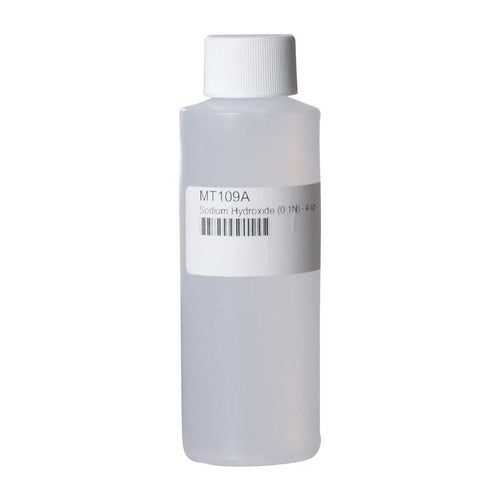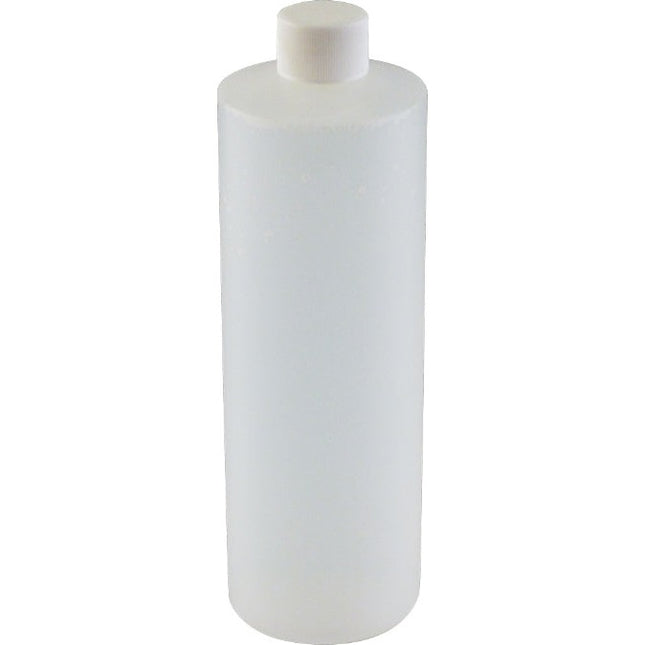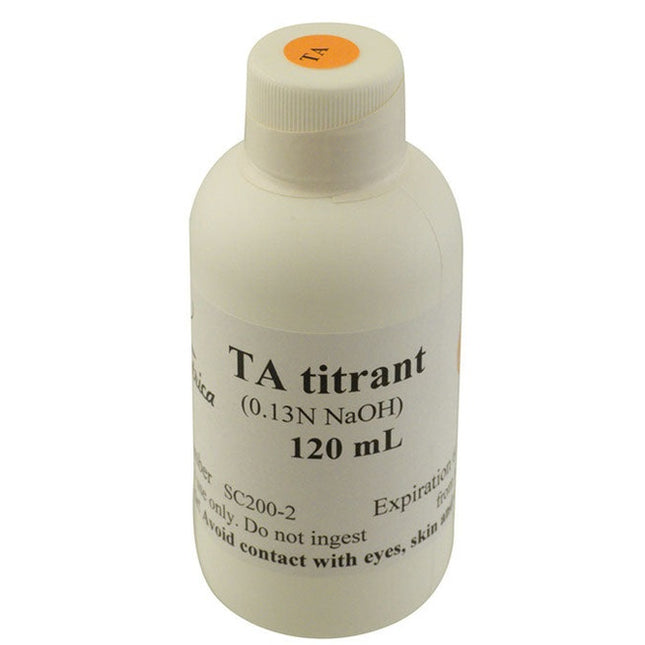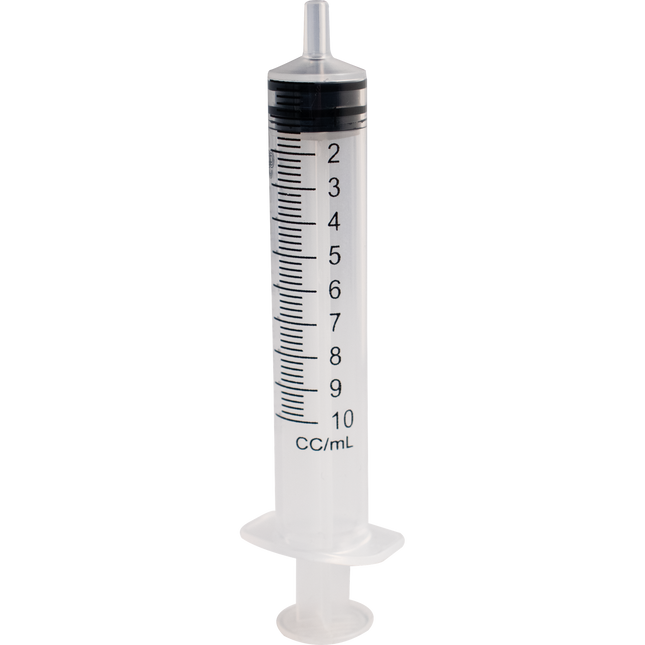TA Test Replacement Parts & Reagents
-


Sodium Hydroxide (0.1 N)
Replacement Sodium Hydroxide for the CellarScience® Acid Test Kit (W501CS) or any other acid test kit which uses 0.1N Sodium Hydroxide. Please Note: This Sodium Hydroxide is 10x stronger than the MT110 product that is used with our MT140 Aeration Oxidation SO2 Test Kit. They are not interchangeable.
$5.59
-

TA Titrant for MT565 & MT570 - 130mL (0.13N Sodium Hydroxide)
This reagent bottle replenishes the TA titrant (0.133N NaOH) found in the SC-200 and the SC-300 Analyzer kits. To avoid cross-contamination with other reagents, use a dedicated syringe to dispense the NaOH reagent. Store reagents in a dark, cool place with the bottle tightly sealed to maximize shelf life. Good for about 12 tests. Guaranteed for 6 months. To avoid cross-contamination with other reagents & solutions, use a dedicated pipette or pour the TA titrant into another container. Store solution in a dark, cool place with the bottle tightly sealed to maximize shelf life. Please note: some bottles of TA Titrant may show 100mL as the volume. This is a misprint. The true volume is 130mL.
$20.00
-

Plastic Syringe | 10 mL | Center Nozzle
This plastic syringe is perfect for measuring out acid additions or other small amounts of liquid. Perfectly suitable for multiple uses in brewing and winemaking applications. Calibrated up to 10 ml. 1 ml is equal to 1 cc. NOTE: The center nozzle syringe is not compatible with the Anton Paar EasyDens. You will need a syringe with offset nozzle.
$2.19
-

Transfer Pipettes (Set of 3)
These pipettes are made of polyethylene, have a 3mL capacity, and an integral bulb. For adding reagents prior to titrating. For use with the SC-100A, SC-200 and the SC-300 analyzers.
$3.75
-

Phenolphthalein - 1% 1oz
Replacement jar of phenolphthalein indicator for the W501 Acid Test Kit. This phenolphthalein is suitable for acid test kits from other suppliers as well. Phenolphthalein will often turn colorless in acidic solutions and red in basic solutions.
$4.99
-

Vinmetrica - Replacement pH Electrode for MT570
Replacement pH electrode for the SC-300 Analyzers that have a manufacturing date after February 2016. Includes the pH Electrode Storage solution. The pH electrode should be properly stored in its electrode storage solution. With proper care and storage, this electrode will have a 2-3 year lifespan beginning with first use. Vinmetrica Troubleshooting Guide
$127.00
-

Support Stand For SO2 Kit
Support Stand For SO2 Kit
$49.99
-

Hanna Calibration Standard for MT694 - 120mL (Hanna# HI 84502-55)
The HI84502-55 is a 120 mL bottle of pump calibration standard that is used to calibrate the dosing system of the HI84502 TItratable Acidity Mini Titrator for Wine Analysis. With 4 mL of solution required per pump calibration, there is enough standard to perform approximately 30 pump calibrations. A calibrated dosing pump allows for the accurate determination of the amount of titrant used when performing a titration. The amount of volume dosed along with the concentration of the titrant is used by the pre-programmed formula within the HI84502 in determining the exact titratable acidity. The pump calibration procedure should be performed anytime the titrant or pH electrode is replaced. Routine calibration is recommended to ensure the highest of accuracy when performing a titration. Pre-measured solution Clearly marked expiration date and lot number Air tight bottle with tamper-proof seal to ensure quality Analysis of titratable acidity in wine, as performed on the HI84502 mini titrator, utilizes a simple sample preparation, a high-quality titrant dosing pump, potentiometric endpoint detector, and automatic computations. As the titrant comes pre-standardized, it is important to determine the amount of titrant delivered by the dosing pump by performing a pump calibration procedure. In this procedure, the analysis of a known volume of a known solution is titrated with to the pH 8.2 endpoint determined by the HI1048B pH electrode. The same pump calibration solution is used for both the low and high ranges. The pump calibration procedure should be performed anytime the titrant, syringe, tubing or pH electrode is replaced. It is recommended to do a pump calibration every time a new set of titrations are to be performed. Replacement reagents required to operate the HI84502 include: Low Range - 0.1 to 5.0 g/L of tartaric acid High Range - 4.0 to 25.0 g/L of tartaric acid Pump calibration standard HI84502-55 Titrant solution HI84502-50 Used to calibrate the dosing system of the HI84502 TA Mini Titrator for Wine Analysis with one bottle allowing for appx 30 (4mL) pump calibrations Clearly marked expiration date and lot number, Air tight bottle with tamper-proof seal to ensure quality.
$49.99
-
Hanna Replacement Electrode for MT682 & MT694 (Hanna# HI 1048B)
The HI1048B is a glass body, refillable, sleeve junction pH electrode with a BNC connector. This electrode features a double junction reference, Hanna's Clogging Prevention System (CPS) technology and spherical glass sensing bulb made with general purpose glass. This pH electrode is ideal for wine must and juice due to their high solids content that would clog a standard general purpose pH electrode. Clogging Prevention System (CPS™) Technology Refillable Electrode Double Junction Design Hanna Instruments offers a wide variety of pH electrodes that are designed for many different applications. The type of glass used for sensing pH, bulb shape, body material, type of junction, type of reference and electrolyte used are just some of the design considerations. The HI1048B uses general purpose (GP) glass, spherical bulb, glass body, sleeve junction with CPS™ technology, double junction and is refillable with 3.5M KCl, making it ideal for wine must, juice, and other samples with a high solids content. General Purpose Glass Formulation General Purpose (GP) glass, as the name implies, is a standard glass formulation that is used for general use. A pH electrode with GP glass will have a resistance of 100 megaohms at 25°C and is suited for measuring the pH of samples that are at ambient temperatures. The HI1048B is suitable to use with samples that measure from 0 to 80°C. Spherical Glass Tip The spherical shaped tip design allows for a wide area of contact with the measured sample. This permits a faster electrode response with a higher degree of stability. CPS Sleeve Junction Clogging Prevention System (CPS) technology is an innovation in for the improvement of pH measurements in samples that have a high solids content. Conventional pH electrodes use ceramic junctions that can clog quickly when used in samples that have a high solids content such as wine must or juice. When the junction is clogged, the electrode does not function. CPS technology utilizes the porousness of ground glass coupled with a PTFE sleeve to prevent clogging of the junction. The ground glass allows the proper flow of the liquid, while the PTFE sleeve repels solids. As a result, pH electrodes with CPS technology take up to 20 times longer to be fouled as compared to conventional electrodes. Double Junction Reference A double junction electrode has an internal compartment surrounding the reference wire. Silver ions are present in the electrolyte of the internal compartment, which houses the Ag/AgCl reference wire; the electrolyte outside this compartment is silver free. The double junction design means that virtually no silver from the electrode enters the sample. This design allows measurement in applications where silver ions in the sample are undesirable or for samples that contain sulfides that can cause the silver to precipitates and clog the junction. The clogging of the junction will result in drifty and erratic readings. Refillable The HI1048B is a refillable probe. Since it is a double junction pH electrode, the fill solution is the HI7082 3.5M KCl. This solution does not contain any silver as with single junction electrode fill solutions. Glass Electrode Body The glass body is ideal for laboratory use. The glass is resistant to many harsh chemicals and is easily cleaned. The glass body also allows for a fast transfer of heat to the internal reference electrolyte. The mV generated by the reference cell is temperature dependent. The faster the equilibrium the steadier the reference potential. BNC Connector The HI1048B has a BNC connector. This type of connector is universal in that it can be used on any pH meter that has a female BNC probe input. Other types of connectors include DIN, screw type, T-type, and 3.5mm to name a few. These types of connectors tend to be proprietary for a particular type of meter and are not interchangeable. Single Junction Versus Double Junction pH Electrodes Conventional electrodes are normally single junction. As depicted by the figure above, these electrodes have only a single junction between the internal reference wire and the external solution. Under adverse conditions, such as high pressure, high temperature, highly acidic or alkaline solutions, the positive flow of the electrolyte through the junction is often reversed resulting in the ingress of sample solution into the reference compartment. If this is left unchecked, the reference electrode can become contaminated, leading to complete electrode failure. Another potential problem with single junction electrodes is the clogging of the junction due to silver chloride (AgCl) precipitation. Silver can be easily precipitate in samples that contain Tris buffer or heavy metals. When the electrolyte solution makes contact with the sample, some AgCl will precipitate on the external face of the junction. The result is drifty readings obtained from the sensor. Hanna’s double junction system, as the name implies, has two junctions, only one of which is in contact with the sample as shown in the figure. Under adverse conditions, the same tendency of sample ingress is evident. However, as the reference electrode system is separated physically from the intermediate electrolyte area, the contamination of the electrode is minimized. The likelihood of clogging of the junction is also reduced with a double junction electrode since the outer reference cell uses a fill solution that is “silver-free”. Since there is no silver present, there is no precipitate forming to clog the junction. Able to measure samples 0 - 80C Glass body, refillable sleeve junction PH electrode with a BNC connector Features a double junction reference with Hanna's Clogging Prevention System (CPS) technology and spherical glass sensing bulb made with general purpose glass Ideal for wine must and juice due to high solid content that would clog a standard general purpose PH Electrode
$264.00
-

Auto Buret Self Zeroing - 10 ml
Auto Buret Self Zeroing - 10 ml. Buret and reagent bottle only, does not include the stand or clamp.
$439.99
-


Double Burette Clamp | Titration Clip | Laboratory Butterfly Clip
Double Burette Holder. Double buret clamp securely holds up to two burets without obscuring graduation lines or numbers.
$39.99












